Introduction
Good oral hygiene is important for maintaining one's overall health. Oral diseases can be considered a public health program due to its high prevalence and significant social impact.
Today, countless numbers of dental health information programs have been conducted in schools. Such campaigns will typically aim not only to impart knowledge, but also to improve attitudes regarding oral health, and to facilitate the transformation of these attitudes into practice.
The change from an unhealthy attitude to a healthy attitude will occur given adequate information adequate motivation and adequate practice of the measures to be adopted by the subject. Most oral diseases are directly related to lifestyle.
So, attainment of good oral health is based upon the awareness of good dietary habits and oral Hygiene practices.
Review Of Literature
Review of literature for the present study has been categorized under the following headings
1. Studies related to prevalence of dental carries.
2. Studies related to knowledge and practices of oral hygiene
3. Studies related to child-to-child approach.
1. Studies related to prevalence of dental carries.
A cross sectional study was conducted to estimate the prevalence of dental caries and treatment needs in school going children of Delhi, in various educational zones of Delhi. A total of 520 school children in age range of 9-12 years were examined using WHO (1997) criteria. The prevalence of dental caries was found to be 52.3% with mean deft and DMFT of 0.5038 ± 1.0859 and 0.8250 ± 1.3437, respectively. Besides various treatment needs 49.7% required restorative treatment. This study shows that lack of awareness and affordability to the dental facilities available. Therefore, there is a need to develop preventive and promotional oral health strategies to combat this infectious disease[1].
A study conducted to assess the relationship between socioeconomic status and oral hygiene, gingival condition, and dental caries among 12- to 15-year-old children from each of the five geographic areas in Irbid, Jordan. Children of low-to-moderate socioeconomic status (n = 674) attending 10 public schools were chosen randomly, children of high socioeconomic status (n = 347) attending 10 private schools were also included. Schoolchildren were examined for oral hygiene, gingival condition, and dental caries. Children attending public schools had bleeding on brushing and calculus, mean plaque and gingival scores were higher in public school children than in private school children, the public school children had higher overall scores for decayed, missing, or filled teeth and surfaces as well as higher scores for decayed teeth and surfaces. However, children attending private schools had significantly more missing and filled teeth and surfaces. The results for oral hygiene, gingival status, and dental caries were worse, but not significantly worse, among poor children than they were among rich children. Therefore, the study suggests dental health education is recommended for both socioeconomic groups[2].
2. Studies related to knowledge and practices of oral hygiene.
A descriptive cross-sectional study carried out to determine the oral health knowledge and oral hygiene practices among primary school going children in Kapsaret Educational division, Uasin-Gishu District, Kenya. The study included the sample of 401school children and selected through random sampling technique. 92% of the students claimed they brushed their teeth. About 48% brushed at least twice daily. More students (59.1%) reported using the chewing stick compared to those using commercial toothbrushes (p = 0.000).Female students brushed more frequently than their male counterparts (p = 0.000, chi2 = 24.65). 39.9% of the students knew the cause of tooth decay, 48.2% could state at least one method of prevention, while 16.5% knew the importance of teeth. Use of toothpaste was reported by 38.9% of the students. This study concluded that there is need to increase the oral health knowledge through well planned school based oral health education programs in the primary schools. This would hopefully lead to improvement on the oral hygiene practices[3].
A study conducted to assess knowledge, attitude, and practice (KAP) toward oral health in a government-aided missionary school of Bangalore city. The study group comprised of 212 children (Male: 108; Female; 104) who were in the age group of 11-12 years. This survey found that only 38.5% of the children brush their teeth two or more times a day. Pain and discomfort from teeth (35.1%) were common while dental visits were infrequent. Fear of the dentist was the main cause of irregular visit in 46.1% of study participants. High proportion of study participants reported having hidden sugar at least once a day: soft drinks (32.1%), milk with sugar (65.9%), and tea with sugar (56.1%). It was found that 5.4% and 3.9% of study participants smoke and chew tobacco; respectively. This study suggests that oral health KAP of study participants are poor and needs to be improved. Systematic community-oriented oral health promotion programs are needed to improve oral health KAP of school children[4].
A Study conducted to determine the Oral Hygiene Practice among School Children of Pokhara Municipality A total of 200 school children of age 3.5-16 years were surveyed randomly The study shows that large number of children (45%) brush randomly, 15% brush vertically and 40% horizontally. These are all improper brushing techniques. They are not well aware about the proper brushing technique. They need to be educated properly. It is concluded that Oral hygiene awareness education and motivation are the basic steps for improving the oral hygiene practices among the school children[5].
3. Studies related to child to child approach
A study conducted in Northern Ireland to assess the effectiveness of child to child approach to promote healthier snacking in primary school children.10 schools randomly selected into intervention and control group. Sample size was 482. Intervention given to the experimental group. Post test given for both experimental and control group regarding dental health. Intervention children had greater increases in their mean knowledge score compared with control children. The study concluded that the child to child approach improved the children’s dental health[6].
A study conducted in Karnataka regarding impact of child-to-child program on knowledge, attitude, and practice regarding diarrhea among rural school children, subjects includes 54 students belonging to 6 class(mean age 11.80 # 0.68) and 54 students belonging to 6 class (mean age 11.95 # 0.56) experimental and control group from two different schools. Child-to-child sessions were conducted for the experimental group. The pretest mean score was 1.44 and post test mean score was 23.57 for the experimental group, the pre test mean score was 4.04 and post test mean score was 3.2 for the control group. The study concluded that the Child to Child program has resulted in significant improvement in the knowledge, development of positive attitudes and healthy practices among study group students[7].
Aim
The aim of this study was to assess the knowledge, attitude, and behavior of school children towards oral health and dental care.
Objective
1. To determine oral health knowledge of school children’s
2. To determine attitude & practice of school children towards oral health.
Materials & Methods
Study group included School students of Army Public School, Bhopal & Peoples Public School, Bhopal (M.P.). School students from VIth to Xth were included in study. Questionnaire consisting of 22 questions contain information on their knowledge, attitude & practice of oral health was distributed to 690 School students.
A 22 item survey was developed using question from existing surveys of providers in practice. The questionnaire contained close-ended & Liker scale questions. The study designed by cross-sectional analysis of School students from VIth to Xth studying in 2 recognized public school of Bhopal ,i.e. Army Public School, Bhopal & Peoples Public School, Bhopal under Central Board Of Secondary Education, INDIA. Sample size constituted 0f 241 students of Peoples Public School, Bhopal & 449 students of Army Public School, Bhopal. The School was attended personally & consent was taken from authority. The questionnaire was described to the students & their feedback was then taken, then & there demographic data including age, genders was collected.
Data was collected & entered into Microsoft Excel Office 2007 spreadsheet that was imported into the statistical analyzer software JMP.
Questionnaire
• Personal details
• Class
• Name of School
• Age
• Sex
Knowledge , Attitude & Practices Of Oral Health Among School Children
Age:____ Sex: ____ Class:____
School: Army Public School / Peoples Public School
Q1 .Do you know how to keep your teeth clean?
Yes
No
Q2. Have you ever been taught How to brush?
Yes
No
Q3. What do you use for cleaning your teeth?
Brush + toothpaste
Dental floss.
Mouthwash.
Toothpicks.
Others
Q4 .Do You clean your teeth with a tooth brush & Toothpastes?
Yes
No
Don’t know
Q5. How often do you brush your teeth?
Less than once per day
Once per day
Twice per day
More than twice per day
Q6. For how long do you brush your teeth?
Less than one minute.
One minute.
Two minutes.
More than two minutes.
Q7 .Do you know whether tooth brushing helps in preventing caries?
Yes
No
don’t know
Q8. Have you been to a Dentist during the past 1year?
Yes
No
Q9 The reason for my last visit to the dentist was:
Dental pain.
Restoration
Scaling
Other reason
Q10. When I first visited the dentist:
I was scared and reluctant.
Slightly afraid.
Very slightly afraid.
I was never afraid.
Q11. How often do you visit your dentist?
Regularly every 6–12 months.
Occasionally.
When I have dental pain.
I never visited a dentist.
Q12: How many are the deciduous / Milk teeth?
18
20
22
24
Q13. How many are the permanent teeth?
26
28
32
36
Q14. Carious teeth can affect teeth appearance?
Yes
No
Q15. Brushing teeth prevents dental decay?
Yes
No
Q16. How many times do You consume sweets a day?
1-2 times
2-3times
more than 4 times
Q17. Do you think sweets cause Dental caries?
Yes
No
Q18. Cold drinks affect the teeth adversely?
Yes
No
Q19. which of the following food causes carious lesion of the teeth ?
Vegetable
Bread & chocolate
Fruit such as apple
Pulses
Non veg
Q20. Which of the following is harmful to teeth ?
Water
Fruit juices
Soft drink
Milk
Q21. Regular visits to the dentist are necessary?
Yes
No
Q22. You care about your teeth as much as any part of your body?
Yes
No
Results
Response rate is 100%
1. 99% of students knows how to brush your teeth by using proper brushing technique , while only 1% were unaware (Fig. 1)
2. 650 responders out of 690 knows proper brushing techniques , while only 40 were unaware. (Fig. 2)
3. 674 students out of 690 uses tooth brush for cleaning there teeth , while other 78 students also uses mouth wash , dental floss , tooth picks and others.(Fig. 3)
4. 668 students were having excellent practice of clening tooth with tooth brush and tooth paste.(Fig. 4)
5. Daily practice of tooth brush is excellent in 71 students , very good in 406 students , fair in 197 students and poor in 15 students.(Fig. 5)
6. 172 students take excellent time to brush there teeth , 477 take fair time whereas time taken by 40 students is poor. (Fig. 6)
7. 521 students agree that tooth brushing helps in preventing dental caries 413 students had been to dentist for treatment and for routine dental check up whereas 274 had only visited dentist when they have severe dental problem. (Fig. 7)
8. More than 200 students had visited dentist because of dental caries whereas more than 300 had visited for other reasons, less than 50 students had visited for reason of restoration and scaling. (Fig. 8)
9. Experience of 265 students during their first visit to dentist was excellent whereas of 139 was not so good rest had an average experience. (Fig. 9)
10. More than 200 students visits regularly to dentist and more than 250 students due to dental pain whereas more than 100 students visits occasionally n less than 100 students has never been to dentist. (Fig. 10)
11. Only 138 students were having Correct knowledge about number of deciduous tooth whereas knowledge of 551 stuudents was poor. (Fig. 11)
12. More than 400 students were having excellent knowledge about number of permanent tooth whereas knowledge of more than 250 was poor. (Fig. 12)
13. 567 students were having excellent attitude towards appearance of tooth due to caries whereas attitude of 116 students was poor for the same. (Fig. 13)
14. 557 students were aware about the fact that brushing your teeth prevents tooth decay whereas knowledge of 132 students was poor. (Fig. 14)
15. 102 students have 1-2times of Frequency of Consumption of sweets per day 550 students consume 2-3times a day while about 37 students were reported with >4 times of frequency of sweets consumption. (Fig. 15)
16. More than 600 students were having excellent knowledge about the fact that sweets causes dental caries whereas knowledge of less than 100 students was poor. (Fig. 16)
17. More than 500 students know that cold drinks are harmful for tooth whereas knowledge of more than 150 students was poor about this. (Fig. 17)
18. About 500 students were having excellent knowledge that Bread & chocolates are cariogenic while about 150 students believed fruits & vegetables & Non-Veg cause’s dental caries. (Fig. 18)
19. About 255 students were having excellent knowledge about harmful food items whereas knowledge of 392 students was fair and about 29 students was poor. (Fig. 19)
20. Knowledge of 518 students about dental checkups was excellent whereas of 168 students was poor. (Fig. 20)
21. Attitude towards taking care of dentition was excellent among 613 students and was poor in 76 students. (Fig. 21)
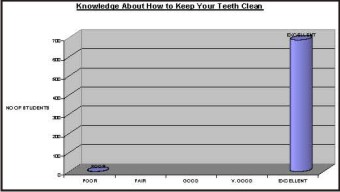 | Fig 1 : 99% of students knows how to brush your teeth by using proper brushing technique ,while only 1% were unaware
 |
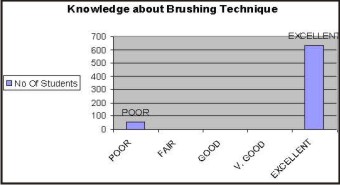 | Fig 2 : 650 responders out of 690 knows proper brushing techniques , while only 40 were unaware.
 |
 | Fig 3 : 674 students out of 690 uses tooth brush for cleaning there teeth , while other 78students also uses mouth wash , dental floss , tooth picks and others.
 |
 | Fig 4 : 668 students were having excellent practice of clening tooth with tooth brush and tooth paste.
 |
 | Fig 5 : Daily practice of tooth brush is excellent in 71 students , very good in 406 students , fair in 197 students and poor in 15 students.
 |
 | Fig 6 : 172 students take excellent time to brush there teeth , 477 take fair time whereas time taken by 40 students is poor.
 |
 | Fig 7 : 521 students agree that tooth brushing helps in preventing dental caries
 |
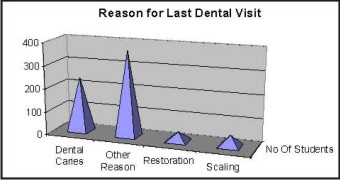 | Fig 8 : More than 200 students had visited dentist because of dental caries whereas more than 300 had visited for other reasons, less than 50 students had visited for reason of restoration and scaling.
 |
 | Fig 9 : Experience of 265 students during their first visit to dentist was excellent whereas of 139 was not so good rest had an average experience.
 |
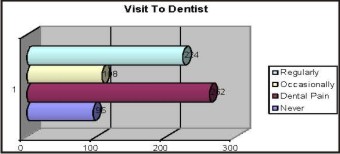 | Fig 10 : More than 200 students visits regularly to dentist and more than 250 students due to dental pain whereas more than 100 students visits occasionally n less than 100 students has never been to dentist.
 |
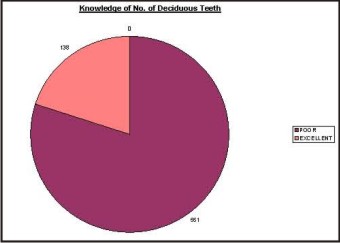 | Fig 11 : Only 138 students were having Correct knowledge about number of deciduous tooth whereas knowledge of 551 students was poor.
 |
 | Fig 12 : More than 400 students were having excellent knowledge about number of permanent tooth whereas knowledge of more than 250 was poor.
 |
 | Fig 13 : 567 students were having excellent attitude towards appearance of tooth due to caries whereas attitude of 116 students was poor for the same.
 |
 | Fig 14 : 557 students were aware about the fact that brushing your teeth prevents tooth decay whereas knowledge of 132 students was poor.
 |
 | Fig 15 : 102 students have 1-2times of Frequency of Consumption of sweets per day 550 students consume 2-3times a day while about 37 students were reported with >4 times of frequency of sweets consumption
 |
 | Fig 16 : More than 600 students were having excellent knowledge about the fact that sweets causes dental caries whereas knowledge of less than 100 students was poor.
 |
 | Fig 17 : More than 500 students know that cold drinks are harmful for tooth whereas knowledge of more than 150 students was poor about this.
 |
 | Fig 18 : About 500 students were having excellent knowledge that Bread & chocolates are cariogenic while about 150 students believed fruits & vegetables & Non-Veg causeās dental caries
 |
 | Fig 19 : About 255 students were having excellent knowledge about harmful food items whereas knowledge of 392 students was fair and about 29 students was poor.
 |
 | Fig 20 : Knowledge of 518 students about dental checkups was excellent whereas of 168 students was poor.
 |
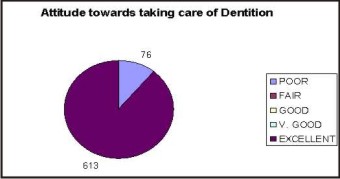 | Fig 21 : Attitude towards taking care of dentition was excellent among 613 students and was poor in 76 students.
 |
Result
Out of 690 students:
99% of students knows how to brush your teeth by using proper brushing technique ,while only 1% were unaware. 650 responders knows proper brushing techniques , while only 40 were unaware.674 students uses tooth brush for cleaning there teeth , while other 78students also uses mouth wash , dental floss , tooth picks and others.668 students were having excellent practice of clening tooth with tooth brush and tooth paste. Daily practice of tooth brush is excellent in 71 students , very good in 406 students, fair in 197 students and poor in 15 students. 172 students take excellent time to brush there teeth, 477 take fair time whereas time taken by 40 students is poor. 521 students agree that tooth brushing helps in preventing dental caries.413 students had been to dentist for treatment and for routine dental check up whereas 274 had only visited dentist when they have severe dental problem. More than 200 students had visited dentist because of dental caries whereas more than 300 had visited for other reasons, less than 50 students had visited for reason of restoration and scaling. Experience of 265 students during their first visit to dentist was excellent whereas of 139 was not so good rest had an average experience. More than 200 students visits regularly to dentist and more than 250 students due to dental pain whereas more than 100 students visits occasionally n less than 100 students has never been to dentist. Only 138 students were having Correct knowledge about number of deciduous tooth whereas knowledge of 551 students was poor. More than 400 students were having excellent knowledge about number of permanent tooth whereas knowledge of more than 250 was poor. 567 students were having excellent attitude towards appearance of tooth due to caries whereas attitude of 116 students was poor for the same. 557 students were aware about the fact that brushing your teeth prevents tooth decay whereas knowledge of 132 students was poor.102 students have 1-2times of Frequency of Consumption of sweets per day 550 students consume 2-3times a day while about 37 students were reported with >4 times of frequency of sweets consumption. More than 500 students know that cold drinks are harmful for tooth whereas knowledge of more than 150 students was poor about this. About 500 students were having excellent knowledge that Bread & chocolates are cariogenic while about 150 students believed fruits & vegetables & Non-Veg cause’s dental caries. About 255 students were having excellent knowledge about harmful food items whereas knowledge of 392 students was fair and about 29 students was poor. Knowledge of 518 students about dental checkups was excellent whereas of 168 students was poor. Attitude towards taking care of dentition was excellent among 613 students and was poor in 76 students.
Conclusion
The results of this study may revel important information about the attitude , knowledge and practice of oral health among school children.
According to the results most of the students are having proper attitude towards oral hygiene but because of lack of knowledge and improper practice their oral health has been avoided.
So parents have the responsibility to teach their child about proper oral care at young age as its easier to develop good habits among young children in comparison to adults.
Recommendation
Oral health education must be included in primary, middle & secondary curriculum of School courses so as to establish an excellent Knowledge, Attitude & Practice of Oral Hygiene.
Further research is needed to examine the students clinically for assessing periodontal and caries status.
These nurturing School Students must be encouraged to be a good role model in promoting oral health education among their friends and family.
References
1. Grewal H, Verma M, Kumar A. Prevalence of dental carries and treatment needs amongst the school children of three educational zones of urban Delhi, India. Indian J Dent Res 2001; 22:517-9.
2. Taani D Q. Relationship of socioeconomic background to oral hygiene, gingival status, and dental caries in children., Quintessence international 2002 Mar; 33(3):195-8.
3. Okemwa KA, Gatogi PM, Rotich JK. The oral health knowledge and oral hygiene practices among primary school children age 5-17 years in a rural area of Uasin Gishu district, Kenya. East Afr J public health 2010 Jun; 7(2):187-90.
4. Harikiran AG, Pallavi SK, Hariprakash S, Ashutosh, Nagesh KS. Oral health-related KAP among 11-12 year old school children in a government-aided missionary school of Bangalore city. Indian J Dent Res2008 Jul-Sep; 19(3):236-42.
5. Baral P, Bhattarai C, Poudel PP, Banstola D, Roy S, Hada S, Hiremath SS. A study on oral hygiene practice among school children of Pokhara municipality. J GMC-Nepal 2009 Jun; 2(5).
6. Ruth freeman, Grace Bunting. A child-to-child approach to promoting healthier snacking in primary school children: a randomized trial in Northern Ireland. Health education 2003; 103(1): 17-26.
7. Walvekar PR, Naik VA, Wantamutte AS, Mallapur MD. Impact on child to child program on knowledge attitude practice regarding diarrhea among rural school children. Indian journal of community medicine. 2006; 31(2).
|